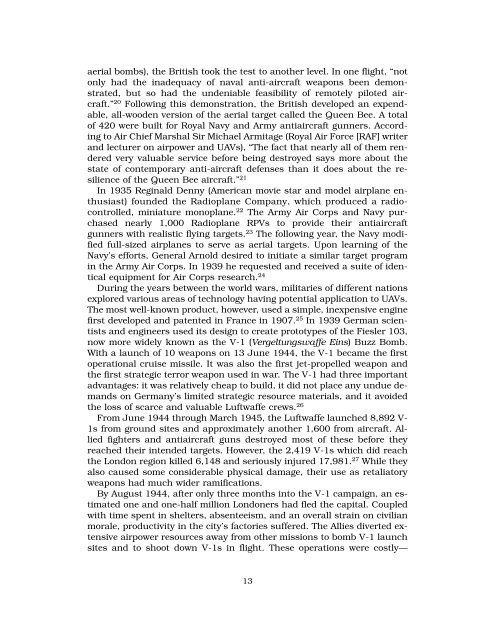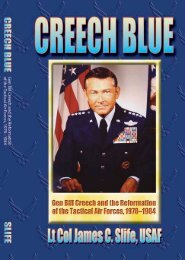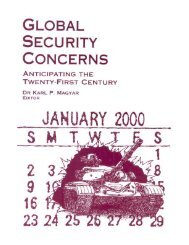Expendable Remotely Piloted Vehicles for Strategic Offensive ...
Expendable Remotely Piloted Vehicles for Strategic Offensive ...
Expendable Remotely Piloted Vehicles for Strategic Offensive ...
Create successful ePaper yourself
Turn your PDF publications into a flip-book with our unique Google optimized e-Paper software.
aerial bombs), the British took the test to another level. In one flight, “notonly had the inadequacy of naval anti-aircraft weapons been demonstrated,but so had the undeniable feasibility of remotely piloted aircraft.”20 Following this demonstration, the British developed an expendable,all-wooden version of the aerial target called the Queen Bee. A totalof 420 were built <strong>for</strong> Royal Navy and Army antiaircraft gunners. Accordingto Air Chief Marshal Sir Michael Armitage (Royal Air Force [RAF] writerand lecturer on airpower and UAVs), “The fact that nearly all of them renderedvery valuable service be<strong>for</strong>e being destroyed says more about thestate of contemporary anti-aircraft defenses than it does about the resilienceof the Queen Bee aircraft.” 21In 1935 Reginald Denny (American movie star and model airplane enthusiast)founded the Radioplane Company, which produced a radiocontrolled,miniature monoplane. 22 The Army Air Corps and Navy purchasednearly 1,000 Radioplane RPVs to provide their antiaircraftgunners with realistic flying targets. 23 The following year, the Navy modifiedfull-sized airplanes to serve as aerial targets. Upon learning of theNavy’s ef<strong>for</strong>ts, General Arnold desired to initiate a similar target programin the Army Air Corps. In 1939 he requested and received a suite of identicalequipment <strong>for</strong> Air Corps research. 24During the years between the world wars, militaries of different nationsexplored various areas of technology having potential application to UAVs.The most well-known product, however, used a simple, inexpensive enginefirst developed and patented in France in 1907. 25 In 1939 German scientistsand engineers used its design to create prototypes of the Fiesler 103,now more widely known as the V-1 (Vergeltungswaffe Eins) Buzz Bomb.With a launch of 10 weapons on 13 June 1944, the V-1 became the firstoperational cruise missile. It was also the first jet-propelled weapon andthe first strategic terror weapon used in war. The V-1 had three importantadvantages: it was relatively cheap to build, it did not place any undue demandson Germany’s limited strategic resource materials, and it avoidedthe loss of scarce and valuable Luftwaffe crews. 26From June 1944 through March 1945, the Luftwaffe launched 8,892 V-1s from ground sites and approximately another 1,600 from aircraft. Alliedfighters and antiaircraft guns destroyed most of these be<strong>for</strong>e theyreached their intended targets. However, the 2,419 V-1s which did reachthe London region killed 6,148 and seriously injured 17,981. 27 While theyalso caused some considerable physical damage, their use as retaliatoryweapons had much wider ramifications.By August 1944, after only three months into the V-1 campaign, an estimatedone and one-half million Londoners had fled the capital. Coupledwith time spent in shelters, absenteeism, and an overall strain on civilianmorale, productivity in the city’s factories suffered. The Allies diverted extensiveairpower resources away from other missions to bomb V-1 launchsites and to shoot down V-1s in flight. These operations were costly—13






